American Railroad Bridges.
Engineering News—July 6, 1889
One of the most interesting papers presented to the American
Society of Engineers at the Seabright Convention is that of Mr.
THEODORE COOPER
on "American Railway Bridges." It is interesting from
the historical matter contained in it, and here first systematically
gathered together, and valuable as showing the progress of a branch
of engineering that has made our country famous for its works
of this nature. The paper is necessarily long, so that we cannot
publish it in full, even did the rules of the society permit,
and we must content ourselves with the following abstract. We
congratulate Mr. COOPER upon the success
attending his efforts to unearth and arrange much matter relating
to the early history of wooden bridge building that has usually
been considered inaccessible.

While the paper is devoted to the railroad bridge, the writer
very properly first briefly sketches the past history of bridges
in America, as well as the imperfect data will permit. The "Great
Bridge," built in 1660 to connect Cambridge and Brighton,
near Boston, was a pile bridge and the first of record. For about
100 years we hear of no other, until, in 1761, SAMUEL
SEWELL built a bridge over York river in
Maine, 270 ft. long, supported on 13 piers. In 1786 this same
SEWELL built a bridge 1,503 ft. long on
75 piers over the Charles river at Boston. Records show that a
year or so later there were similar bridges at Malden and Beverly,
Mass. In 1792 Col. WM. P. RIDDLE
erected the Amoskeag bridge at Manchester, N. H. This structure
was 556 ft. long, and was supported on five piers and two abutments.
It was commenced on August 3, "at which time the timber was
growing and the rocks dispersed in the river," and was finished
on September 29. Between 1785-92 Col. HALE
crossed the Connecticut river at Bellows Falls with a bridge 368
ft, long in two spans. The West Boston bridge, 3,383 ft. long
on 180 pile bents, was finished in 1793.
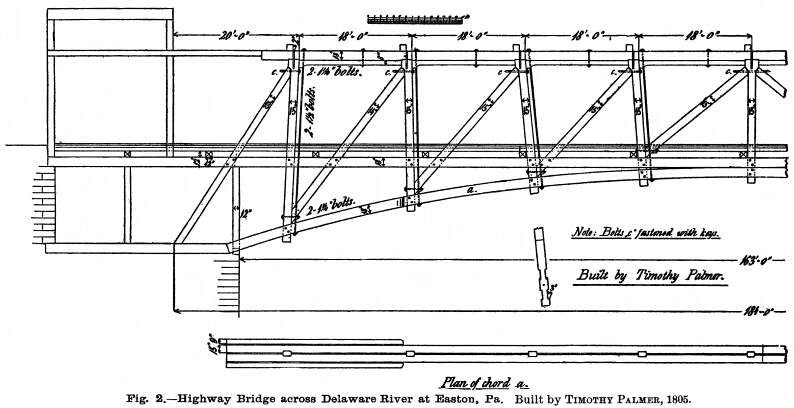
About 1800 a pile bridge, in 25 ft. bents and nearly one mile,
long, was built over Cayuga Lake, N. Y. In 1795 the Mohawk river
was crossed by a bridge 960 ft. long on 13 piers. In 1792 TIMOTHY PALMER built the
Essex-Merrimac bridge over the Merrimac 3 miles above Newburyport,
Mass. There were two bridges starting from Deer Island in the
river. An arch of 160 ft. span and 40 ft. above high water made
up one bridge; but of the other it is only known that it was "wider,"
with a center arch of 140 ft. But it is also stated that the arch
on the Newbury side "is hung on chains" from the high
steep banks, and that it was "the 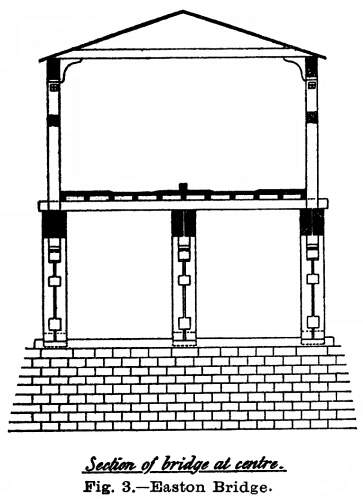 first
chain bridge in New England." In 1793 PALMER
built another bridge over the same river at Andover, and, in 1794,
the Piscatauqua bridge, 7 miles above Portsmouth, N. H. This last
bridge was 2,362 ft. long, with the greater part of pile work.
But over the center of this river was "a stupendous arc"
of 224 ft. 6-ins. span, with a versed sine of 27 ft. 4 ins., and
the depth of the framework of arch was 18 ft. 3 ins. The arch
segments were selected from crooked pieces of timber, so that
the fibre might run in the direction of the curves, and the general
arrangement was such as to justify the local historian in remarking
that this "is allowed to be a masterly piece of architecture,
planned and built by the ingenious TIMOTHY
PALMER, of Newburyport, Mass." In
1796 PALMER built abridge over the Potomac,
at Georgetown. first
chain bridge in New England." In 1793 PALMER
built another bridge over the same river at Andover, and, in 1794,
the Piscatauqua bridge, 7 miles above Portsmouth, N. H. This last
bridge was 2,362 ft. long, with the greater part of pile work.
But over the center of this river was "a stupendous arc"
of 224 ft. 6-ins. span, with a versed sine of 27 ft. 4 ins., and
the depth of the framework of arch was 18 ft. 3 ins. The arch
segments were selected from crooked pieces of timber, so that
the fibre might run in the direction of the curves, and the general
arrangement was such as to justify the local historian in remarking
that this "is allowed to be a masterly piece of architecture,
planned and built by the ingenious TIMOTHY
PALMER, of Newburyport, Mass." In
1796 PALMER built abridge over the Potomac,
at Georgetown.
In 1796, RUFUS GRAVES
built a bridge over the Connecticut river, at Hanover, N. H.,
consisting of a single arch of 236 ft., patterned after the Piscatauqua
bridge of PALMER. This bridge fell in 1804
by its own weight. In 1795, a bridge 1,000 ft. long, made up of
four arches and one draw-span, was erected between Newbury and
Haverhill. It was carried away by ice in 1818. In 1794, PALMER built the bridge at Haverhill, with three
arches of 180-ft. span, supported on handsome piers 40 ft. square.
Bridges at Windsor, N. H., Rowley, Mass., and two over the Lehigh
at Bethlehem and Easton, complete the record as far as found for
the eighteenth century.
In 1804-06 the Permanent Bridge over the Schuylkill at Philadelphia
was designed and built by TIMOTHY PALMER. This bridge is shown in Fig. 1, and lasted
until 1850, when it was renewed by a more modern wooden arch and
widened to carry a railroad track. In 1805 Mr. PALMER built the
bridge at Easton, Pa., on a very similar design, shown in detail
in Fig. 2. This Easton bridge had three spans of 163 ft. in the
clear, and is still in use after 84 years' service, with about
five-sixths of the timber yet in good condition.
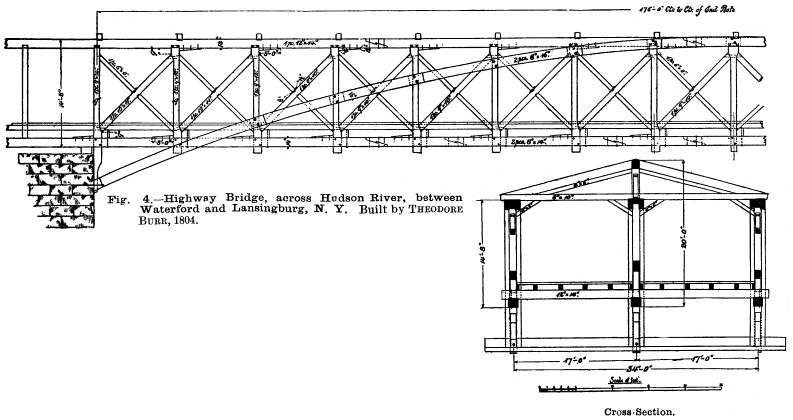
In 1804 THEODORE BURR,
built the Waterford bridge over the Hudson, consisting of four
arch spans of 154 ft., 161 ft., 176 ft., and 180 ft. This bridge
was built of hewn yellow pine and was not covered until 1814.
It is still in use and in reasonably good condition (see Fig.
4). BURR also built another bridge over the Hudson, at Fort Miller,
and in 1804-06 built the Trenton bridge (Fig. 5) over the Delaware
river. This bridge had five arch spans, two of 203 ft., one of
198 ft., one of 186 ft., and one of 161 ft. in the clear. Each
span had five arched ribs, made of white pine plank, 4 ins. thick,
and breaking joints in an arch 32 ins 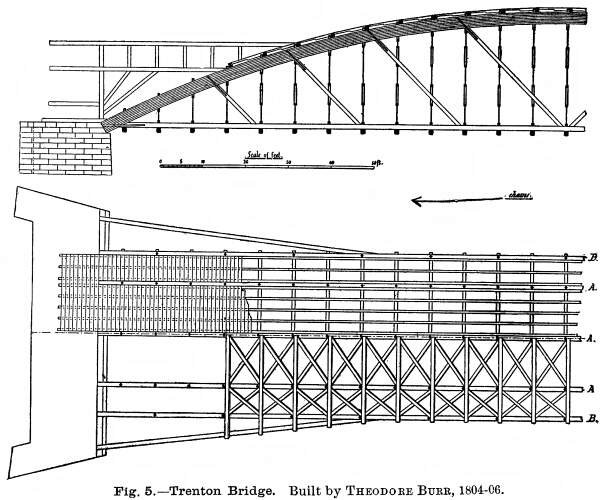 deep.
The lower chord was made of two sticks 6½ x 13½
ins. The roadway was suspended by vertical chains. The arch footings
required renewal in 1832; In 1848 the bridge was remodeled by
removing the wing arches shown, and adding a new and stronger
arch on the south side, and strengthening the old arch rib so
as to carry a railroad track; in 1869 it was again strengthened;
and in 1875 it was replaced by the present iron structure. deep.
The lower chord was made of two sticks 6½ x 13½
ins. The roadway was suspended by vertical chains. The arch footings
required renewal in 1832; In 1848 the bridge was remodeled by
removing the wing arches shown, and adding a new and stronger
arch on the south side, and strengthening the old arch rib so
as to carry a railroad track; in 1869 it was again strengthened;
and in 1875 it was replaced by the present iron structure.
The Schenectady bridge over the Mohawk (Fig. 7) was built by
BURR in 1808, replacing a previous bridge
also built by him, which had fallen before or just after construction.
The tradition is that the first bridge was to have two spans of
450 ft. each. The second bridge is a curiosity in bridge construction,
for it is a suspension bridge in wood. The curved ribs were made
of eight 4 x 14-in. plank spiked or bolted together, with the
planks cut to long bevels for splicing. There were three ribs
spaced about 13 ft. apart, and the timber used was white pine.
This bridge stood thus for 20 years, until the excessive sagging
made it necessary to put additional piers under the middle of
each span. In 1873 it was replaced by an iron bridge.
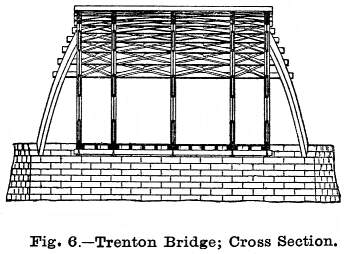 In 1812-16 THEODORE
BURR built the bridge over the Susquehanna
at Harrisburgh, Pa., with twelve spans of 210 ft. One-half of
this bridge still remains, connecting an island with the mainland. In 1812-16 THEODORE
BURR built the bridge over the Susquehanna
at Harrisburgh, Pa., with twelve spans of 210 ft. One-half of
this bridge still remains, connecting an island with the mainland.
LEWIS WERNWAG
built his "Colossus" bridge over the Schuylkill river
at Philadelphia in 1812. This bridge, with its clear span of 340
ft. 3¾ ins., was destroyed by fire on Sept. 1, 1838. In
1814 WERNWAG built the Newhope bridge over
the Delaware river, with six arched spans of 175 ft. each. In
1810 he built a wooden cantilever bridge over the Nashamony river,
Pa., and called it his "Economy" bridge and claimed
that it could be used to advantage up to 150-ft. spans. WERNWAG built many bridges from this date to
1836, including his first railroad bridge in 1830 at Manogway
on the Baltimore & Ohio R. R., and his last bridge carried
the railroad over the canal and Potomac at Harper's Ferry, Va.
(See ENGINEERING NEWS,
Aug. 15, 1885, for plans of this and two other Wernwag bridges
here described.
—ED. ENG. NEWS.)
All of the previously mentioned bridges of any magnitude seem
to have been arch bridges, and the first marked step towards bridges
of modern-truss form was the wooden lattice, patented by ITHIEL TOWN in January,
1820. This bridge (Fig. 8) had its horizontal members, or chords,
composed of two or more parallel sticks so spaced that the diagonal
web members passed between them. The timbers were usually 2 to
4 ins. thick and 10 to 12 ins. wide. The timbers were of one size
and of reasonable dimensions, and all connections were made with
wooden treenails, so that these features, combined with the simplicity
of its erection, made it a cheap and popular structure. A great
number of these bridges were built in the United States, up to
spans of 220 ft. for both highway and railway purposes, and many
of them ore still in existence.

The next step toward simplicity of construction was the truss
patented by Lieut. Col. STEPHEN H. LONG, U. S. Engineers, in March, 1830, and November,
1839. Many of his bridges were combined with the arch, as was
also the Town lattice, especially for long spans. In 1840 WILLIAM HOWE patented
the truss which was the basis of the present well-known Howe truss
bridge. For some years this latter, was the standard truss for
use on railroads.
In April, 1844, THOMAS W. and CALEB PRATT patented the
truss known under their name, which differed from the Howe truss
in having the diagonals in tension and made of iron and the verticals
under compression were in wood, just the reverse of HOWE'S
patent. The Pratt became the favored form and was afterwards adopted
for iron bridges, and is therefore one of the steps in the development
of American bridges.
The history of iron bridges really reaches back to 1786, when
THOMAS PAINE made
three models for a bridge over the Schuylkill in Philadelphia—one
in wood, one in cast-iron, and one in wrought-iron connected with
blocks of wood representing cast-iron blocks. At this time the
only iron bridge in England was the cast-iron arch over the Severn
near Coalbrook Dale. PAINE took his 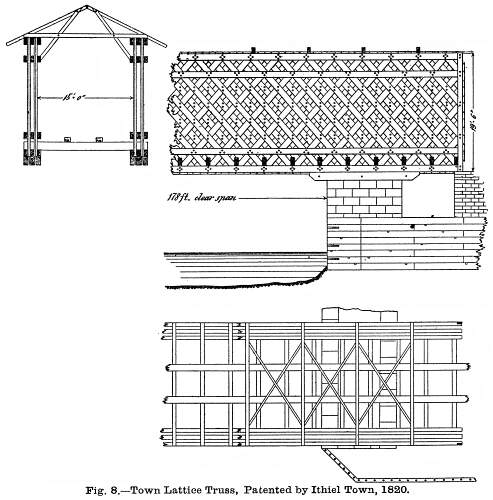 last model to Paris in 1787, and proposed
it for an arch bridge of 400-ft. span, and afterwards actually
had built in England five cast-iron arch ribs of 110 ft. span
to test his theories; but the engineer's interest in bridges was
lost in his interest in the French Revolution, and his bridge
was sold for the benefit of his creditors. He made a vain attempt
in 1803 to enlist the U. S. Congress in his bridge building projects. last model to Paris in 1787, and proposed
it for an arch bridge of 400-ft. span, and afterwards actually
had built in England five cast-iron arch ribs of 110 ft. span
to test his theories; but the engineer's interest in bridges was
lost in his interest in the French Revolution, and his bridge
was sold for the benefit of his creditors. He made a vain attempt
in 1803 to enlist the U. S. Congress in his bridge building projects.
Nothing more was done with iron bridges until about 1830, when
LONG and TOWN both
suggested that their bridges could be built of iron. In 1833 AUGUST CANFIELD took out
the first patent for an iron truss bridge, and the first one actually
built is believed to be the one erected over the Erie canal, at
Frankford, N. Y., in 1840, by Mr. EARL
TRUMBULL. But in the same year SQUIRE
WHIPPLE built his first iron bridge, and
he took out a patent on April 24, 1841. In 1846-47, JAMES
MILLHOLLAND built a boiler-plate tubular
girder 55 ft. long for the Baltimore & Ohio R. R. In 1846,
FREDERICK HORBACH
patented an iron Howe truss, and a bridge of this type was built
in 1846-47 on the North Adams branch of the Boston & Albany
R. R., near Pittsfield, Mass. In 1847-50, NATHANIEL
RIDER built for the New York & Harlem,
Erie, and other railways, a number of iron bridges with parallel
top and bottom chords and multiple systems of vertical posts and
diagonal ties. The top chords and posts were cast-iron and the
lower chord and ties were flat bars of wrought-iron. The failure
of one of these Rider bridges in 1850 on the Erie R. R., following
the failure of the English bridge over the river Dee, caused the
officials of the line to declare iron bridges untrustworthy and
they directed all iron bridges, consisting of several Rider and
some Whipple bridges, to be taken down. They were replaced by
wooden structures.
It is claimed that the general adoption of iron for railroad
bridges was given its first impulse by Mr. BENJAMIN
H. LATROBE when, as Chief Engineer of the
Baltimore & Ohio R. R., he extended the road from Cumberland
to Wheeling and decided to use this material in all the bridges.
His assistant was then Mr. ALBERT FINK, whose plans were adopted for all these
structures.
From henceforward it will be sufficient simply to give the
names and dates of some of the more prominent early iron bridge
designers. In 1852 a Bollman truss of 124 ft. was built at Harper's
Ferry, and in 1851-52 three 205 ft. Fink trusses were built over
the Monongahela river. In 1852-53 SQUIRE
WHIPPLE built an iron bridge of 146 ft.
span on the Rensselaer & Saratoga R. R., 7 miles north of
Troy, N. Y., on the type afterwards known as the Whipple truss.
It continued to do good service until 1883, when it was taken
down, owing mainly to the great increase in the rolling loads
coming upon it.
Mr. F. C. LOWTHORP built his first railroad
bridge in 1857 on the Catasauqua & Fogelsville R. R. In 1856
JOHN W. MURPHY,
C. E., built a Whipple bridge, still standing, over the Saucon
Creek for the North Penna. R. R., and in 1858-59 Mr. MURPHY
built a Whipple-Murphy truss over the canal at Phillipsburg, N.
J., with 165 ft. span. In this bridge he substituted pins of unturned
wrought-iron and looped eyes on his tension members, for the cast
trunnions on the foot of the Whipple post and the wrought-iron
links there used. This, Mr. COOPER says,
is the first truss bridge that he has been able to discover that
was pin-connected throughout. In 1861 Mr. JOHN
H. LINVILLE built a bridge on the Delaware
extension of the Penna. R. R. over the Schuylkill river, in which
were used for the first time wide forged eye-bars and posts formed
of wrought-iron sections. The bridge built by JOHN
W. MURPHY over the Lehigh in Mauch Chunk,
in 1863, was the first in which he used wrought-iron for both
posts and top-chord sections, and it was probably the first American
truss in which the tension and compression members were both of
wrought iron. He used cast-iron joint blocks and pedestals, however.
The Post truss was first used in 1865 by Mr. S. S. POST
on the Erie railway. In 1859 Mr. HOWARD
CARROLL commenced building riveted lattice
bridges for the New York Central R. R. and its connections, and
was followed therein by Mr. CHARLES HILTON, his pupil. In 1864, Mr. FELICIAN
SLATAPER designed and built a bridge of
five riveted lattice spans of 178 ft. each over the Allegheny
river at Pittsburg.
Mr. LINVILLE inaugurated the era of
long-span bridges in America with a channel span of 320 ft. in
the Steubenville bridge over the Ohio river, built between 1863-64.
Mr. FINK followed in 1868-70 with the Louisville
bridge, with two main spans of 360 and 390 ft. In 1870 Mr. LINVILLE put 340 ft. spans in the Parkersburg
and the Bellaire bridges over the same river, and in 1872 he built
the Newport and Cincinnati bridge with a channel span of 420 ft.
In 1868-74 Mr. JAMES B. EADS
built the St. Louis bridge with its two arches of 503 ft. and
center arch of 520 ft. clear span. In 1876 the Cincinnati Southern
bridge was built with a 519 ft. truss (the largest truss span
to that time) from specifications of Mr. G. BOUSCAREN
and designs by Mr. J. H. LINVILLE. The
channel spans of the Henderson Bridge, 522 ft., and of the Ohio
River, Kentucky Central R. R. bridge, at Cincinnati, 550 ft.,
are the only independent truss bridges up to this time, with greater
spans.
There are now in existence on American railroads over five
miles of bridges with spans from 300 to 400 ft., nearly four miles
with spans from 400 to 500 ft., and two and one-half miles with
spans exceeding 500 ft. estimated as single-track bridges and
excluding wire suspension bridges.
The first cantilever bridge of importance was built in 1876-77
by C. SHALER SMITH
over the Kentucky river. The second and third were the Niagara
and the Frazer river bridges, designed by Mr. C. C. SCHNEIDER,
the first in 1883 and the other in 1885. The largest cantilever
is the Poughkeepsie bridge, lately completed.
The remainder of Mr. COOPER'S paper
is devoted to designing and proportioning bridges, the strength
of material and parts of skeleton structures, the manufacture
of bridges, the erection of bridges, the relative merits of typical
American railroad bridges, and statistics of the amount and kind
of bridges on the railroads of the United States. This matter
is of a character that cannot be dealt with justly or usefully
by an abstract, and we will not attempt at present to give any
more than the above outline of its value.
Bridge Page
| Contents Page
|







